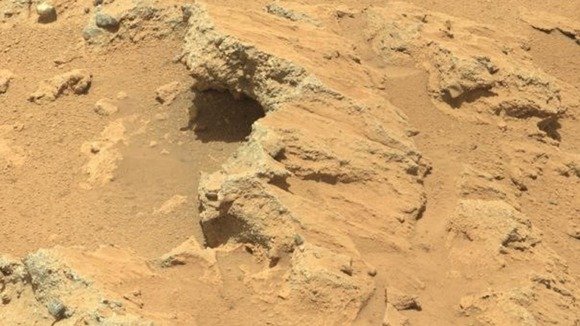Water on Mars: Scientists have definitive proof that water existed on Red Planet
Scientists have found definitive proof that many of the landscapes seen on Mars were indeed cut by flowing water.
The valleys, channels and deltas viewed from orbit have long been thought to be the work of water erosion, but it is NASA’s latest rover, Curiosity, that has provided the “ground truth”.
Researchers report its observations of rounded pebbles on the floor of the Red Planet’s 100 mile-wide Gale Crater.
Their smooth appearance is identical to gravels found in rivers on Earth.
Rock fragments that bounce along the bottom of a stream of water will have their edges knocked off, and when these pebbles finally come to rest they will often align in a characteristic overlapping fashion.
Curiosity has pictured these features in a number of rock outcrops at the base of Gale Crater.
It is confirmation that water has played its part in sculpting not only this huge equatorial bowl but by implication many of the other landforms seen on the planet.
“For decades, we have speculated and hypothesized that the surface of Mars was carved by water, but this is the first time where you can see the remnants of stream flow with what are absolutely tell-tale signs,” said Dr. Rebecca Williams from the Planetary Science Institute.

Mars valleys, channels and deltas viewed from orbit have long been thought to be the work of water erosion
NASA first announced the discovery of the pebbles in September last year, barely seven weeks after Curiosity had landed in Gale.
Researchers have since been studying the robot’s pictures in more detail and have now written up a report for Science magazine – the first scholarly paper from the surface mission to make it into print; and the study reinforces the initial interpretation.
It describes the nature of the outcrops, and estimates the probable conditions in which their sediments were laid down.
The pebbles range in size from about two to 40 mm in diameter – too big to have been blown along by the wind.
These clasts, as scientists will often call them, are cemented together in a sandy matrix to make a rock type referred to as a conglomerate.
In many places, the clasts are touching each other, and the pictures show examples of so-called imbrication – an arrangement where elongated pebbles stack like a row of toppled dominos. It is a classic sign of past river activity.
Precisely dating landforms on Mars is not possible, but the rock outcrops seen by the rover are almost certainly more than three billion years old.
Curiosity’s pictures have enabled the team to make some informed statements about the speed and depth of the water that once flowed across the crater floor.
The pebbles come in a variety of dark and light shades, further indicating that they have been eroded from different rock types and transported from different locations.
Using its Chemcam remote-sensing laser, the rover was able to detect feldspar in the lighter toned clasts.
Feldspar is a common mineral on Earth that weathers quickly in the presence of water.
This suggests past conditions were not overly wet and that the pebbles were carried only a relatively short distance – probably no more than 10-15km.
This fits with satellite observations of what appears to be a nearby network of old rivers or streams spreading away from the mouth of a channel that cuts through the northern rim of Gale Crater.
This valley – or Peace Vallis as it is known – is the probable route down which the water flowed and later dumped its load of rounded gravels.
Curiosity is due to drive back on itself in the coming weeks as it makes for the big peak, Mount Sharp, at the centre of the crater.
Scientists hope this will take the vehicle past similar rock outcrops so that additional pictures can be obtained.
[youtube qhhvEx-MAgA]
